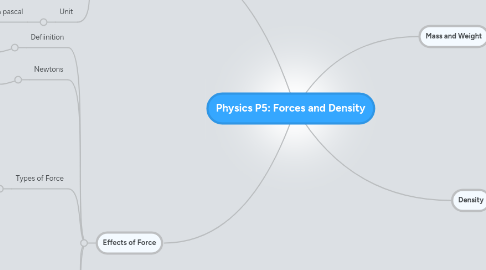
1. Effects of Force
1.1. Defiinition
1.1.1. A force changes the size, shape, or state of motion of a body.
1.2. Newtons
1.2.1. Force is measured in newtons, named after Isaac Newton.
1.2.1.1. 1 Newton is equal to 1kg*1m/s squared
1.3. Types of Force
1.3.1. Non-contact
1.3.1.1. Gravity
1.3.1.2. Electrostatic
1.3.1.3. Magnetic
1.3.2. Contact
1.3.2.1. Drag (Air Resistance)
1.3.2.2. Normal Contact Force
1.3.2.3. Tension/Compression
1.3.2.4. Friction
1.3.2.5. Nuclear
1.4. Spring
1.4.1. Extension= Stretched length minus original length
1.4.2. Hooke's Law
1.4.2.1. The extension of a spring is proportional to the load.
1.4.2.1.1. F=kx
1.5. Motion
1.5.1. Every force in one direction has an equal force in another direction.
1.5.1.1. The lift and weight are balanced, and the air resistance are balanced with the thrust, so the (plane) object is in constant motion.
1.5.1.2. If the forces aren't equal, the the object will accelerate/decelerate until the forces are balanced.
1.5.2. A system is in equilibrium when there is NO resultant force.
2. Pressure
2.1. Gasses exert pressure on the sides of their container when they bounce off the inside wall of the container, pushing out with a force.
2.2. Solid objects may also feel pressure if two objects are pushed together.
2.3. Formula
2.3.1. Pressure is equivalent to the force over the area of which the force is being exerted upon. p=f/a
2.4. Unit
2.4.1. The unit of pressure is a pascal
2.4.1.1. 1 pascal is equivalent to 1Nm^-2

